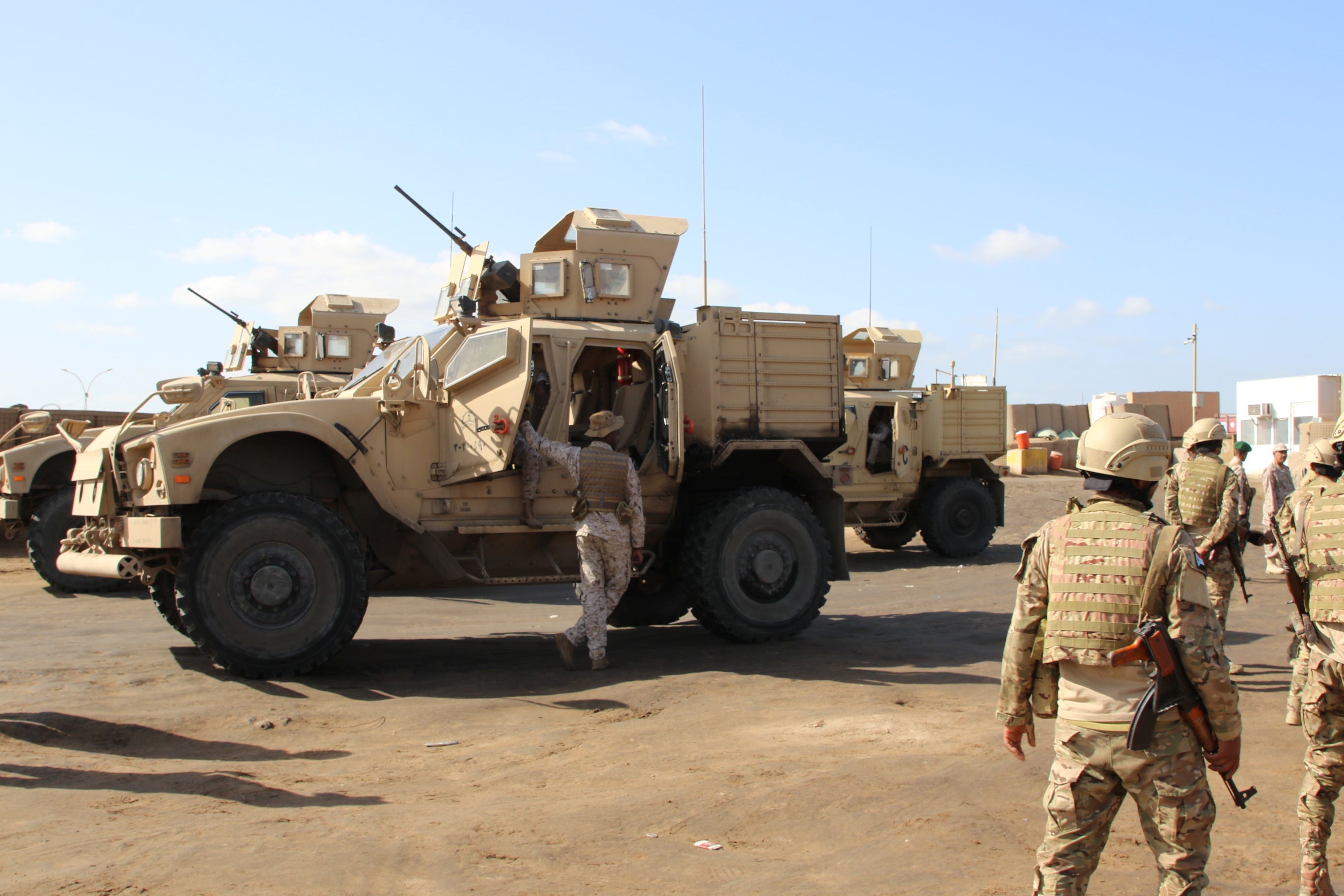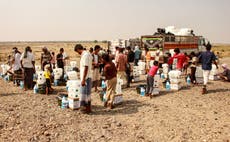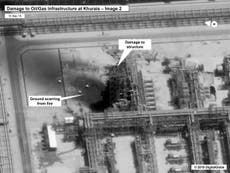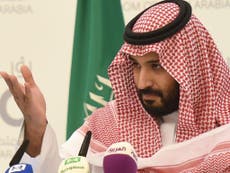From the frontlines in Yemen: No end in sight as Saudi general accuses Iran of increased support for rebel fighters
In Yemen, where the sound of gunfire has become part of normal life, Oliver Poole is told why there is no quick way out after five years of bloodshed

Your support helps us to tell the story
From reproductive rights to climate change to Big Tech, The Independent is on the ground when the story is developing. Whether it's investigating the financials of Elon Musk's pro-Trump PAC or producing our latest documentary, 'The A Word', which shines a light on the American women fighting for reproductive rights, we know how important it is to parse out the facts from the messaging.
At such a critical moment in US history, we need reporters on the ground. Your donation allows us to keep sending journalists to speak to both sides of the story.
The Independent is trusted by Americans across the entire political spectrum. And unlike many other quality news outlets, we choose not to lock Americans out of our reporting and analysis with paywalls. We believe quality journalism should be available to everyone, paid for by those who can afford it.
Your support makes all the difference.Landing at the airport in Aden, the port city presently serving as Yemen’s capital, requires a descent over the shining blue water of the Arabian Sea and the score of tankers waiting at anchor. Beneath the waves can be made out the shape of half a dozen more tankers, now sunk and rusting.
At the airport itself, sunglass-sporting soldiers ring the runway, automatic rifles gripped. As our convoy of SUVs pulls out through the main gate, four shots are fired into the air to clear the traffic. No one in the surrounding vehicles looks surprised at this sudden burst of gunfire.
Two burnt-out Russian T55 tanks, a model first produced 65 years ago, stand a short distance ahead, both bent and broken by age and shell damage. Everywhere in this place, it seems, are the inescapable reminders of violence and past and present turmoil.
This is a dangerous land, it screams at you. A place where wars are fought and won or lost but struggle always continues – and where it is certainly continuing now.
I am there on the invitation of the Saudi Arabian government to spend some days with its troops in Yemen. They are the latest of the deployments that have been rotating into and out of the country ever since the Saudi military joined with nine other mainly Arabic countries back in 2015 to act after a group of Yeminis from the north, called the Houthis, deposed the elected president and sought to take control.
It was expected to be a quick intervention, one in which the overwhelming technological superiority of the Saudi-led coalition would quickly defeat the limited weapons of the Houthi. But it did not work out that way.
The Houthis were battled hardened and wily after having already spent the previous years in a guerrilla war against the government. And they are supported by Iran – if not significantly at the beginning of the conflict, then certainly significantly now – which has been accused of seeing a way to further spread its policy of struggle-through-proxy, which had already proved so successful in Lebanon and then Iraq, to bog down new Arab opponents.
Now, five years later, the Saudi coalition is still here. There have been wins. There have been losses. There have been diplomatic agreements. There has been the tragedy of some 12,000 civilians killed, including many women and children, according to the well-regarded database ACLED, and millions of Yeminis who consequently endured hunger and risked famine in what the United Nations has named as the world’s worst man-made humanitarian crisis.
But the upshot of all this suffering has been a military reality in which Yemen, a country twice the size of the United Kingdom, is still divided into warring parts.
The Houthis hold areas in the north and centre. The government, supported by the coalition, has as its sphere of influence Aden as well as the south and the east, over which it has some if not total control. The reality is that much of the country is mountainous, like Afghanistan; it is hard for anyone truly to take charge of.
Entering the room where the Saudi Arabian commander in Aden, Brigadier General Nayef Al-Otaibi, is sat with much of his top staff and the local governor, Ahmed Hamed Lamlas, the overall sensation is one of exhaustion. Eyes ringed with dark fatigue stare at me from above medical masks, the wearing of which even here defines these Covid times we are living through.
As so often in such places and such wars, they want to show me a PowerPoint presentation.
I have seen these in Baghdad, Kabul and Mogadishu. The attempt to order chaos and confusion onto slides by demonstrating the efforts being made by military people to desperately bring things under control; to desperately – somehow – bring their operation to a close so they can finally go home.
In Baghdad I remember sitting as an earnest American official went through slide after slide showing the actions they were taking to help Iraqi life chances by combatting cancer through stamping out the smoking of tobacco. Outside, suicide bombers were almost weekly blowing themselves up in markets, and much of the country was in full-blown revolt.
Here, true to form, the focus is on the development projects that are being undertaken. For reasons I cannot understand, as the content is the opposite of anything that could be considered secret, I am told not to take any notes of what is said. Which is actually counter-productive, as there are clearly efforts being enacted by his team to at least build rather than destroy schools and provide streetlights and other amenities, whatever the reality might be of their long-term impact.
The young Saudi official giving the briefing has that fervour in his task that is again so familiar from other such presentations in similar places undertaking similar projects. It reminds me of the young British woman from the Department for International Development promising with conviction how she was helping bring true democracy to Basra ahead of the 2005 election there; or the Ugandan soldier in Somalia explaining how the African Union force he was part of would ensure children got back to school.
When I die, what I achieve here will be what I will be measured by.
The presenter this time may be dressed in a headdress, long white robes and the green waistcoat that marks him as a member of the Saudi Development and Reconstruction Programme, but there is the same, almost reverential, conviction in their mission and its ultimate righteousness.
Later that evening, as we eat dinner, he is sat beside me. He will be here for four years, he says, spending six months at a time and only then going home for a fortnight to see his wife and young child.
“Is it worth it?” I ask him.
“Oh yes,” he promises me. “When I die, what I achieve here will be what I will be measured by.”
The top Saudi officer present, Brig. Gen. Al-Otaibi, is in no doubt as to why this operation had gone on so much longer than originally conceived, and why he is now commander of troops still stuck in Aden when it had been hoped they would no longer have to be here. There is one reason above all, he insists, one malignant body whose involvement he believes the media does not adequately take to task, and that inevitably is Iran.
There are positives in what is being achieved, he says: “The most positive thing is the cooperation with the Yemini government and the government agencies. Then what we see from the Saudi development programme, which facilitates our presence here in Aden, and how we have seen the great cooperation with the people here in Aden, which makes things easier for us.
“What we are worried about is the extent of the move by the Houthi to extend their role. Working with the government, we have captured some of the soldiers coming from Sana’a. Their objective is to target the coalition and the government agencies; to spread their guys around Aden.
“The people which we have captured here in Aden: they are supported by Iran. They have Iranian arms. This is the way of the Iranian.”
One of his assistants has placed on the glass table beside me a plate of nuts and biscuits, with a bowl of honey in its centre. As we talk, a fly circles and lands in the middle of the honey pot. It starts to struggle as its legs became trapped, searching for a way to escape.
The Brigadier General’s words are not surprising as, for the Saudis, Iran’s presence looms large in this conflict. In 2015, Saudi Arabia led its coalition of states – among them the United Arab Emirates, Egypt and Jordan. with the United States and United Kingdom offering weapons and logistical support – to intervene in Yemen’s civil war when the Houthi rebels agreed to allow direct flights between Sana’a and Tehran, as well as to give Iran access to the port of Hodeidah.
In Riyadh, this it seems was viewed as the latest front in a regional challenge. To their north were Shia Muslim Iranian Revolutionary Guards assisting the Shia-dominated Iraqi government; to the north-west, Iranian Revolutionary Guards assisting the government of President Bashar al-Assad against Isis. In Lebanon, the Iran-backed Hezbollah. Now they perceived Iran moving into their own backyard.
The Houthis are Shia, but a specific set called Zaydi Muslims whose beliefs are often closer to that of Sunni Muslims. They had had contacts with Iran and its client Hezbollah for decades but, in 2015, the Iranians and Hezbollah had probably only dozens of advisers and experts in Yemen and had likely trained a handful of Houthis in Iran and Lebanon. Now, however, the Iranian presence is widely agreed to be much more pervasive. Earlier this year, the Brookings Institution pointed to Iran’s growing influence, particularly in its support for the Houthis’ missile capabilities.
In 2017, when the blockade of the country’s ports was tightened, the Saudis said their decision was a reaction to the smuggling of advanced weaponry into Yemen to arm the Houthis.
The result of this was a disaster for the Yemenis, with Unicef among the international bodies who have told how the result was also a block on vital aid from international organisations that only exacerbated hunger and resulted in the spread of disease, including a cholera epidemic that is still ongoing.
In Yemen, some 24 million people need humanitarian assistance, warned the UN Under-Secretary-General for Humanitarian Affairs and Emergency Relief, with 10 million of them a step away from famine.
Appeals from the West did not result in the the grip of the blockade being loosened. Nor did they stop the Iranians delivering a steady supply of firearms and funding to their local allies, or to them providing critical expertise and equipment to assist the Houthi missile and drone programme that is keeping up a steady fire on Saudi cities and military bases.
This costs Iran little compared to the fortune the Saudis have spent on the war. But it is effective. Indeed, two days after I left Yemen, a Houthi cruise missile – one the Saudis claimed was provided by the Iranians – smashed into an oil facility in the Saudi city of Jeddah.
The day before that attack I was in Jeddah myself, taking the opportunity to see the twisting streets and ornate wooden shutter of its old town before flying home. Now the city had been under missile assault. This conflict is clearly no longer limited to Yemen’s borders.
When would you hope Saudi troops can leave Yemen, I ask the Brigadier General.
He smiles. “I hope tomorrow,” he says.
During my time in Yemen, I am flown up to al-Ghaydah to see the revamped airport that has been built there with Saudi money, its glass walls gleaming in the sunlight, and hear how it is hoped it will help the area become a hub for tourism, which at least in the short term seems an extremely unlikely prospect.
I am driven around the safer parts of the country, and see how here some entrepreneurship is growing with some neighbourhoods a hub of building work and local construction. I am told repeatedly how things are getting better, but also told when I ask to visit specific areas or talk to specific people that it would not be safe or it would not be appropriate to do so.
Such is the reality of such state-facilitated trips. They give you the opportunity to see what you are shown, and thanks to the security provided by your hosts to do so safely, but there is no opportunity to see what they would rather you did not.
In such places and on such visits, all I know that you can know for certain is what you see with your own two eyes and what it left me with is that depressing knowledge, one which I have experienced too often elsewhere, of soldiers sent to a foreign land to undertake a task that, despite all their late nights and long hours of efforts, is escaping from them like sand slipping through their hands. Everyone, it seems, knows there is no chance they will be going home tomorrow.
Back in Aden, the local governor leaned against a tasselled cushion and listed to me the horrors that he said had been enacted on the people of his city when the local branch of Al-Qa’eda had had a stronghold there.
“The terrorists had established a court that was executing people,” Mr Lamlas says, his eyes wide and white above the flash of maroon of the Oxford knot of his tie. “They would execute them by either a bullet or by cutting off their heads. After then they would crucify them. They would tie them by the hands and hang them from a bridge.
“The ex-governor, Gen. Jaafar Mohammed Saad, one of my predecessors, one morning he went to open a school and kindergarten. A suicide bomber received them with a suicide car and he killed the governor and those with him. Some of the parents of the kids were killed as well. That time we had two front lines. We were fighting that group and we were fighting the Houthi. It was terrible.”
Through the window behind him, I can see the shape of Siri Island looming out of the darkness. It is a stark volcanic outcrop nearly entirely encircled by the Arabian Sea. On its summit stands a stone fortress, its stone walls illuminated at night by spotlights.
It was originally built in the 12th century by the Turks, during their wars here. In the subsequent centuries it has been attacked by the Portuguese as they sought to gain a foothold; then garrisoned by the British during their time as rulers here. Now it looks down on the troops of the latest military force in town as the cycles of violence continue.
The governor tells me of his worry at the lasting impact the war could be having on the mentality of his people. “The challenge is how can we work with the youth,” he says. “Their psychology has changed as a result of the fighting. To change that back to civilian life, that we have to work on.”
He gently leans forward, his hands now clasped in front of him, as he stares at me. “The challenges are huge,” he says.








Join our commenting forum
Join thought-provoking conversations, follow other Independent readers and see their replies
Comments